Topical
Tip: Notes
on using the LOMO darkfield condenser for both darkfield and annular brightfield
Compiled by David Walker, with tips
by David Walker (UK) and Ted Clarke (USA),
images by David Walker.
Dedicated
darkfield condensers by the big name makers can be expensive but for LOMO users,
the OI-13 NA 1.2 oil immersion darkfield condenser is quite affordable and often comes up on the secondhand
market. Some notes on using this condenser
are compiled below, both from the author's experiences and Ted Clarke's, where
mentioned.
|
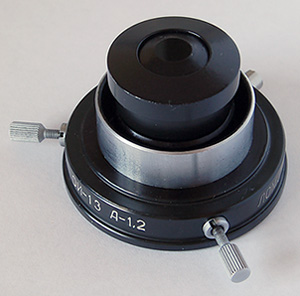
The LOMO
OI-13 NA 1.2 oil immersion darkfield condenser in centering mount.
When new it is supplied in a fitted wooden box, with manual and
funnel stop for the LOMO 90x objective. Secondhand, as the author's
example, the stop, manual and box may be missing but can
be cheaper, typically less than £25.
|
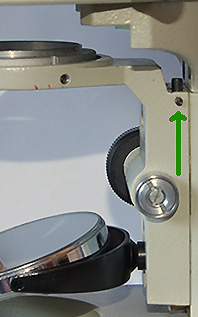
The condenser focus
stop pin and screw are highlighted on the LOMO Biolam (Multiscope
in US). This stop setting may need adjusting for the darkfield
condenser to focus, see text.
|
Note
on installation and use
The
immersed condenser works very close to the underslide of the slide. Sometimes
the condenser upper focus limit stop on the LOMO Biolam stand may have been set conservatively by the
makers which although fine with the Abbe condenser, the darkfield condenser may
not focus close enough. This applies to the author's stand. The stop pin in
theory is adjustable with the captive screw under the stage but the pin may
be seized, as in the author's example. A workaround is to unscrew the optical
assembly a few mm out of its mount to increase the height.
If
adjusting the condenser and or pin height, hold say the edge of a plastic credit
card (to avoid scratching condenser) across the stage aperture with condenser
focussed fully up to ensure it's not set high enough to hit slide when in use.
At the highest mags hitting the slide may risk damaging the slide and / or objective.
In
darkfield mode
The
maker's manual suggests that for immersion objectives, a funnel
stop is required to reduce the objective's NA to 0.85 (if it doesn't have an iris).
However, from the author's trials (and Ted Clarke's, personal communication)
this NA limit seems a little conservative and it's worth trying darkfield at full NA up
to an NA of ca 1.0 as the condenser gives excellent
darkfield i.e. an inky black background with, for example, the LOMO 60x NA1.0 apo oil.
See example shown below.
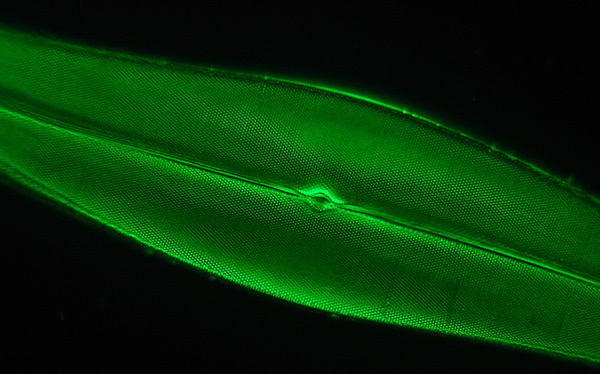
Diatom
Pleurosigma angulatum, Klaus Kemp eight form test slide in Hyrax available
from www.diatoms.co.uk.
LOMO
OI-13 oil immersed darkfield condenser, LOMO 60x NA1.0 oil apo with
iris set at full NA, green filter, tungsten lamp. LOMO 7x eyepiece.
Sony
P200 consumer digicam supported over eyepiece. Out of camera image -0.7EV
from auto exposure, resized.
Use
for annular brightfield ('COL') with high NA objectives
In darkfield,
the condenser presents an annular ring of light outside the
objective's NA and the familiar image of the bright subject
set against a black background is seen. But if the same NA 1.2 darkfield condenser
is used with objectives of higher NA, brightfield
is created because the annular ring of light now lies just within
the objective's back focal plane. This creates a form of annular brightfield
or 'circular
oblique illumination' (COL) exploiting nearly the full NA of the objective. See
footnotes for a selection of resources on the various aspects of annular
brightfield.
Using
a darkfield condenser for COL is a technique Ted Clarke (USA) encouraged me to try
as he has already used it to good effect with a LOMO stand (personal communications). (See my
article last month for an example
of use with a Nikon Labophot and Nikon NA 1.4 darkfield condenser).
|
Right: Actual image of the back focal plane of the LOMO 90x NA1.3 oil apo
focussed on a subject when using the LOMO darkfield condenser
oil immersed. The ring sits just inside the full aperture of the
condenser.
To generate some modelling, the aperture of the field iris
can be partly blocked off if desired to create a crescent of variable
size. Or the condenser slightly decentered (as R M Allen does in
his example, see refs.)
In conventional brightfield the condenser aperture would usually
be
stopped down further than this for acceptable contrast.
|
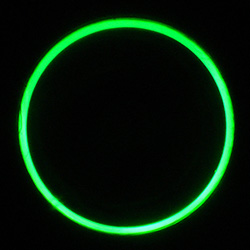
|
As
has been remarked by others on annular brightfield, the technique may or may not work well
with a given objective and / or subject, so is very much a 'try it and see'
technique. The author and Ted Clarke have found the LOMO 90x NA1.3 apo can work
well with certain subjects with annular brightfield with the darkfield condenser.
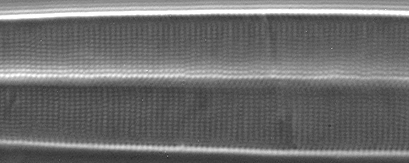
The
diatom Amphipleura pellucida (specimen length 90 Ķm) using annular
brightfield slightly decentered and the LOMO 90x NA 1.30 objective.
LOMO K7x eyepiece.
Klaus Kemp eight form test slide in Hyrax available
from www.diatoms.co.uk.
Violet
400 nm LED mounted in LOMO OI-19 external lamp, i.e. at the visible
light - near UV border. (All work with webcam, see this article
for safety notes when using such LEDs.)
Camera 1.3 Mpixel
Opticstar PL-130M. Crop of single image from camera, tonal balance
adjust and resize.
High NA COL on the author's LOMO / camera combination at least, does seem to have a restricted tonal range which although the
eye tends to tolerate, digital or film imaging can give a less than striking
look, cf
the strong contrasty modelling with highlights conventional oblique can give. Tonal balance
corrections of the image can improve matters. It can also give
a veiled look overall to the imagery possibly because of any out of focus particles
being emphasised.
Because the condenser can give extreme oblique, under some circumstances
false structure (see top left, image above) e.g. outside the periphery of a diatom can occur; something the microscopist of
course needs
to be very wary of. This isn't unique to the
COL form of oblique but far as I can tell from own imagery, the
artefacts when they occur seem
to be mainly of out of the plane of focus diatom edges and don't think internal
false detail is being created. As with all microscopy techniques, the
user is best to be wary of using a single technique
in isolation especially on unfamiliar structures without confirming any
structures seen are genuine with other lighting techniques.
Comments to the
compiler
David
Walker
are welcomed.
Acknowledgements
Thanks to Ted Clarke for personal communications where he has shared his experiences
with the darkfield condenser and for encouraging me to try the high NA COL technique. Thanks
also for a copy of the darkfield condenser manual.
Thanks to Klaus Kemp for his excellent diatom test plates and type
slides (available from
his website www.diatoms.co.uk),
and for making them so affordable to the hobbyist.
A
selection of resources
on annular brightfield
Paul James has an excellent suite of Micscape articles
on many aspects of COL, in particular using the annular rings of a phase condenser to
create the technique.
Frithjof
Sterrenburg discusses the technique in Chapter 8 of his 'Microscopy Primer'
in the section 'Phase-contrast
on the house' hosted on Micscape.
R M Allen, discusses
and illustrates an example of its use in 'Photomicrography' with a darkfield
condenser, 1958, 2nd edition,
p.276.
Willis W. Mathews,
'The Use of Hollow-Cone Illumination for Increasing Image Contrast in
Microscopy', Transactions of the American
Microscopical Society, Vol. 72, No. 2 (Apr., 1953), pp.
190-195. First page accessible on JStor.
The author describes the use of a modified Abbe condenser to create the effect.
W
G Hartley in the Quekett Monograph No. 6, 1983, 'The microscope a beginner's
guide', p. 32 mentions the technique using a darkfield condenser.
Historical
note: An example of a 19th century mention of annular brightfield is
by W. Carpenter in his 2nd edition 1857 of 'The microscope and its revelations'.
On p. 124 he has a footnote to his discussion on darkfield and references the
paper below which is available free on the 'Journal
of Cell Science' website archive.
J.
C. Hall.
'Original Communications: On an Easy Method of viewing
certain of the Diatomaceś', Quarterly Journal of Microscopical
Science. 1856 s1-4: 205-208.
© Microscopy UK or their contributors.
Published in the September 2007 edition of
Micscape.
Please report any Web problems or offer general comments to
the
Micscape
Editor
.
Micscape is the on-line monthly magazine of the Microscopy
UK web site at
Microscopy-UK
© Onview.net Ltd, Microscopy-UK, and all contributors 1995
onwards. All rights reserved.
Main site is
at www.microscopy-uk.org.uk
with full mirror
at www.microscopy-uk.net
.




